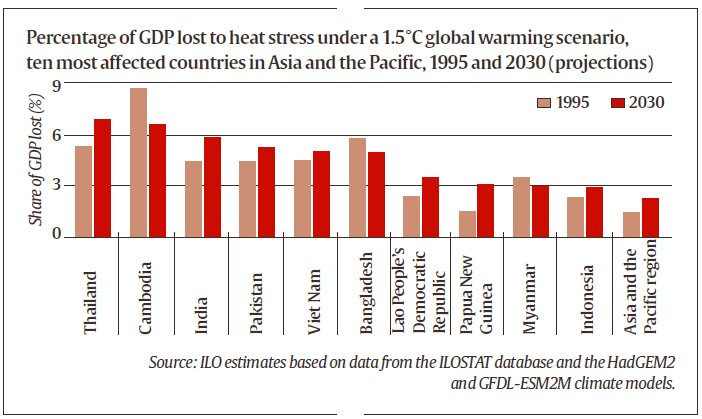Indian Economy
Heat Stress and Labour Productivity: ILO Report
- 03 Jul 2019
- 5 min read
The International Labour Organisation (ILO) in its report ‘Working on a Warmer Planet: The Impact of Heat Stress on Labour Productivity and Decent Work’ revealed that rising heat stress due to climate change could lead to the loss of 80 million jobs by 2030.
- The report makes its projections based on a global temperature rise of 1.5°Celsius by the end of the century.
Heat Stress
- It refers to heat in excess of what the body can tolerate without suffering physiological impairment.
- It generally occurs at temperatures above 35°C, in high humidity.
- Excess heat during work is an occupational health risk as it restricts workers
- Physical functions and capabilities,
- Work capacity and thus, productivity.
- Extreme heat can cause heat-related illnesses, such as heat stroke and exhaustion, increase mortality, and exacerbate existing health conditions.
- According to the World Health Organisation heat stress linked to climate change is likely to cause 38,000 extra deaths a year worldwide between 2030 and 2050.
Key Findings
- Economic Loss: 2% of total working hours worldwide is projected to be lost (costing the global economy $2.4 trillion) every year, either because it is too hot to work or because workers have to work at a slower pace.

- Affected Sectors:
- Agricultural workers, especially women, who make up the bulk of the 940 million laborers in the sector will be most affected.
- Agricultural sector is projected to account for 60% of global working hours lost due to heat stress by the year 2030.
- Construction sector will also be severely impacted with an estimated 19% of global working hours lost by 2030.
- Other sectors like environmental goods and services, refuse collection, emergency, repair work, transport, tourism, sports and some form of industrial work will be worst affected by rising heat.
- Agricultural workers, especially women, who make up the bulk of the 940 million laborers in the sector will be most affected.
- Affected Regions:
- The regions losing the most working hours are expected to be southern Asia and western Africa, where approximately 5% of working hours are expected to be lost in 2030.
- According to ILO, India lost 4.3% of working hours in 1995 because of heat stress, and it is projected to lose 5.8% of its working hours in 2030, which corresponds to 34 million jobs.
- Most of the impact in India will be felt in the agricultural sector and more working hours are expected to be lost in the construction sector, where heat stress affects both male and female workers.
- Social Consequence:
- It could lead to more inequality between low and high income countries and worsening working conditions for the most vulnerable.
- Heat stress will affect millions of women who make up the majority of workers in subsistence agriculture, as well as men who dominate the construction industry.
- The social consequences of heat stress may include increasing migration, as workers leave rural areas to look for better prospects.
Way Forward
- Design, finance and implement national policies to address heat stress risks and protect workers.
- Adequate infrastructure and improved early warning systems for heat events, and improved implementation of international labour standards such as in the area of occupational safety and health to help design policies to tackle heat-related hazards.
- Employers and workers are best placed to assess risks and take appropriate action at the workplace so that workers can cope with high temperatures and continue to do their jobs.
- Employers can provide drinking water, and training on recognizing and managing heat stress.
- Social dialogue can play a crucial role in reaching consensus on indoor and outdoor working methods, adapting working hours, dress codes and equipment, use of new technologies, shade and rest breaks.




